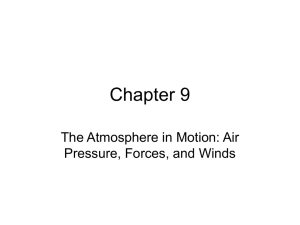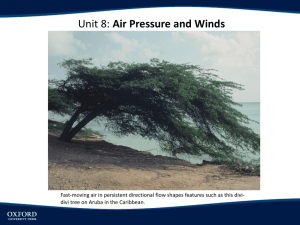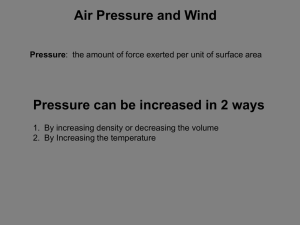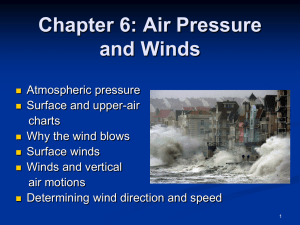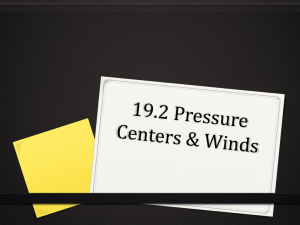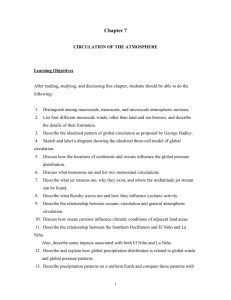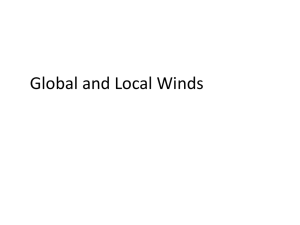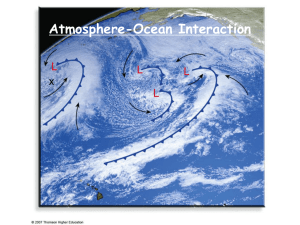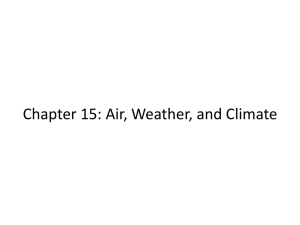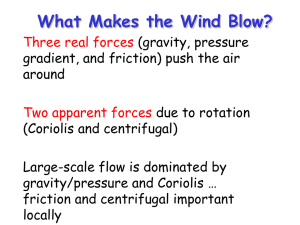Chapter 6 - Weather Underground
advertisement
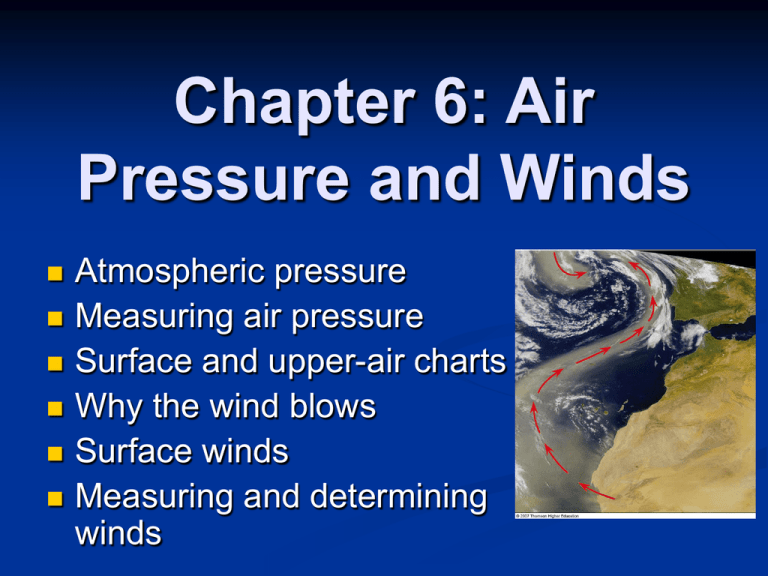
Chapter 6: Air Pressure and Winds Atmospheric pressure Measuring air pressure Surface and upper-air charts Why the wind blows Surface winds Measuring and determining winds Atmospheric Pressure We already know that air pressure is the weight of the air above you We also know that if you move up in the atmosphere, pressure ALWAYS decreases But how does it change in the horizontal? For that, we need a model Atmospheric Pressure Here, we have a model that comes with several assumptions Air molecules are NOT crowded close to the surface Width of air column does NOT change with height The air is unable to move in and out of the column What happens when we force air into the column? Force air out of the column? How do we do this? Atmospheric Pressure Now suppose we have two columns of air with the same pressure, same temperature, and same elevation What happens when we cool one column and warm the other? What happens to the heights of the columns? Atmospheric Pressure The cold column becomes more dense and the warm column becomes less dense The air pressure remains the same/changes? Atmospheric Pressure This means that a short column of air can exert the same pressure as a tall column of warm air Warm air aloft/high pressure. Cold air aloft/low pressure Atmospheric Pressure This pressure gradient causes a force (the pressure gradient force) to move air from high pressure to low pressure. The pressure gradient force IS ALWAYS FROM HIGH PRESSURE TO LOW PRESSURE Atmospheric Pressure So, if we allow air movement, air will leak out of column 2 and into column 1 This creates what kind of pressure at the surface in each column? Atmospheric Pressure So, we get a circulation where the air above a high pressure is sinking and air above a low pressure is rising So, heating and cooling can cause differences in air pressure Stepped Art Fig. 6-2, p. 143 Barometers Barometer – an instrument that measures pressure changes Mercury barometer Barometers Aneroid barometer Metal box called aneroid cell Small changes in pressure cause cell to expand or contract Different words on readings display weather types Pressure Readings Station pressure – the reading from a barometer not corrected to sea-level Sea-level pressure – the reading from a barometer corrected to sea-level Adjustments are usually 10 mb / 100 m Pressure Readings Pressure Readings Once all the readings are taken, you can create isobars – lines of constant pressure Specifically, this is a surface map Surface and Upper Air Charts Isobaric maps – shows height variations along constant pressure Surface and Upper Air Charts Contour lines - lines that connect equal elevation above sea level Isotherms – dashed red lines that show lines of equal temperature (cold air to the north/lower heights) Surface and Upper Air Charts Ridges – elongated highs (warm air) Troughs elongated lows (cold air) Wind arrows blow parallel to lines in 500 mb map Why The Wind Blows Newton’s first law? An object at rest will remain at rest and an object in motion will remain in motion (constant velocity) as long as no force is exerted on the object Newton’s second law? Force exerted on an object equals its mass times the acceleration. Acceleration is change of speed OR DIRECTION F = MA Forces that Influence the Wind Wind is the net result of several forces. With many forces acting, remember it is the net we are looking for. Pressure gradient force (PGF) Coriolis force Centripetal force Friction Pressure Gradient Force Pressure gradient Difference in pressure / distance Pressure gradient force – the force acting on air that is directed from high pressure to low pressure. The main reason for wind. Strong PGF – sharp change in pressure with distance Weak PGF – gentle change in pressure with distance Fig. 6-11, p. 151 Coriolis Force Coriolis force – an apparent force due to the rotation of the earth Coriolis Force Movie Coriolis Force While the ball moves in a straight path, the merry-go-round rotates beneath it. By the time gets to the other side, the receiver has moved It seems as though a force has acted on it, but it is an apparent force because an outside observer sees the ball go in a straight path This occurs for all free-moving objects Coriolis Force Cause wind to deflect to the right in the Northern Hemisphere and to the left in the Southern Hemisphere Coriolis Force Factors that affect the Coriolis Force (CF) The higher the speed, the stronger the CF The higher the latitude, the stronger the CF CF is 0 at the equator and maximum at the poles Straight-line Flow Aloft Example of PGF and CF in action PGF always acts from High to Low. CF acts to the right of motion Geostrophic wind Wind that blows parallel to isobars in a straight path Curved Winds Around Lows and Highs Aloft Cyclonic flow – wind that blows around a low Anticyclonic flow – wind that blows around a high Curved Winds Around Lows and Highs Aloft Centripetal force – inward directed force in a circular path Gradient wind – wind that blows at a constant speed, parallel to curved isobars Curved Winds Around Lows and Highs Aloft Thus, wind flows counterclockwise around a low and clockwise around a high in the Northern Hemisphere. Reverse for the Southern Hemisphere Winds on Upper-level Charts Where temperatures change quickly, large height changes are noticed Meridional – winds that blow north to south Zonal – winds that blow west to east Stepped Art Fig. 6-19, p. 158 Surface Winds Planetary boundary layer (friction layer) Upwards to 1000 m. Friction – interaction with surface that decreases wind speed near the surface Surface Winds Friction slows wind speeds, PGF becomes greater than CF, and wind flows inward to low pressure systems and outward from high pressure systems Winds and Vertical Motions Convergence into surface lows causes rising air Divergence from surface highs causes sinking air Winds and Vertical Motions Hydrostatic equilibrium – the balance between the upward directed PGF and gravity The Influence of Prevailing Winds How do you determine wind direction? Wind is given by the direction it is coming from. Northerly wind blows from the north Prevailing winds – wind most often blowing during a given time Wind Instruments Wind vane – points into the wind Anemometer – measures wind speed Aerovane – gives wind speed and direction
